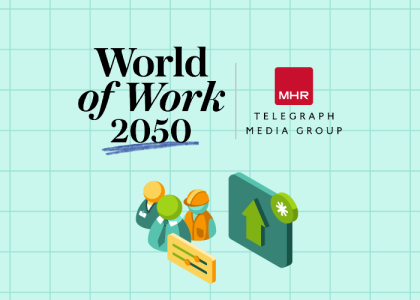Why the future of business depends on employee wellbeing

Prioritizing employee wellbeing improves retention, productivity, and innovation. Discover how MHR’s People First platform helps businesses thrive.
There’s one simple reason employee wellbeing matters more than ever. We spend most of our lives working. Roughly 90,000 hours.
And that’s not just a statistic. It’s a wake-up call for employers. Because if work takes up that much time, it plays a huge role in people’s mental, physical and even financial health. So, if organizations want to succeed long-term, your people’s wellbeing needs to be a priority, not an afterthought.
The wellbeing shift: Employee expectations have changed
Employees today expect more. They’re looking for workplaces that value more than output, where wellbeing isn’t a buzzword but part of the everyday culture.
As psychologist and workplace wellbeing expert Dr Justin Henderson explains: “The psychological stressors that you’re subjecting yourself to for eight or 10 hours a day, every day, five days a week, has a collective erosion on our mental and physical health over time.”
Unchecked, that stress leads to burnout, poor performance and high turnover. And businesses pay the price. But when employers support wellbeing, the benefits are real for individuals and the wider business.
What is employee wellbeing, really?
Wellbeing isn’t just yoga and fruit bowls. It’s about creating a culture and environment where people can do their best work, and feel good doing it. And it covers three key areas:
- Physical – Having the energy, health and balance to function well each day
- Mental – Feeling emotionally supported and socially connected at work
- Financial – Having control and confidence in your money, now and in the future
True multi-level wellbeing strategies take a holistic view of all three. The businesses that get this right see big returns: More motivation, less burnout, better ideas, stronger teams, and people who want to stick around.
So, what does wellbeing at work look like in practice?
One organization leading the way is Inspire Education Group (IEG), one of our customers. They’ve rolled out a full program of wellbeing initiatives, from dedicated wellbeing days to employee support groups that tackle real-life challenges.
“As leaders, we really focus on how we create the right environment so people can thrive,” shares Rachel Nicholls, CEO of IEG.
Inspire Education Group is building a workplace where people feel cared for and can show up as their best selves at work. It’s made a clear difference in morale, retention and performance — proof that when wellbeing is embedded in the work culture, results follow.
In addition to keeping your people happy, workplace wellbeing also drives high performance and builds a culture that retains talent in a competitive market.
How technology brings wellbeing to life
Wellbeing strategies can only work if they’re embedded in the day-to-day. And good intentions aren’t enough. You need the infrastructure to support your people. That’s where employee engagement platforms like People First come in, giving HR teams the tools to turn strategy into action, and build a genuinely people-centric workplace.
Here’s how People First helps drive wellbeing:
- Check-ins – Enables employees and managers to book and log regular two-way conversations directly via People First, creating space for support, performance tracking, and personal development
- Recognitions –Makes it easy for employees and managers to celebrate wins and acknowledge great work by posting recognitions on People First, where everyone can share – boosting morale and connection
- Newsfeed – Keeps teams informed and connected with shared updates, shout-outs, and company news
- Communities – Creates digital social spaces that bring people together, from hobby groups to wellbeing circles, helping build a stronger workplace culture
These flexible features don’t just make work better, they help people feel better.
The business case is clear
Investing in wellbeing isn’t just the right thing to do, it makes business sense. Organizations that put wellbeing first see:
- Higher motivation and productivity
- Lower burnout and absenteeism
- Stronger retention and job satisfaction
- Better collaboration and teamwork
- Greater creativity and innovation
- Fewer workplace accidents
- Improved mental health
- A more positive company culture
And that culture? It becomes your competitive edge.
Learn more: The science behind the strategy
Want to dig deeper into the why? Our World of Work 2050 webinar series explores the science of employee wellbeing, and what businesses can do now to prepare for the future. You can sign up once and access all sessions — past and upcoming — via our new interactive video hub.
Featuring experts like Stephen Watson, Chief People Officer at Shaw Education Trust, these sessions are packed with insights for business leaders who want to make wellbeing a strategic advantage.



